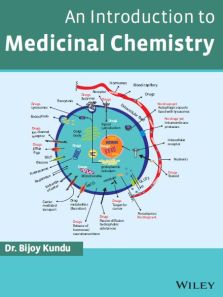An Introduction to Medicinal Chemistry
ISBN: 9788126599882
476 pages
For more information write to us at: acadmktg@wiley.com

Description
The present book “An Introduction to Medicinal Chemistry” is an introduction to the chemical and biological parameters, challenges and underlying principles involved in the early stages of drug discovery from bench to preclinical stage. My main objective has been to compile various aspects of drug discovery principles in the form of a handbook instead a textbook. The book may provide one-stop information dealing with mechanistic, biological and chemical aspects of drug design and improvisation of their actions. This has been exemplified by providing relevant examples of drugs for a better understanding.
Chapter 1 Cell Signaling and Diseases
1.1 Introduction
1.2 Chemical messengers
1.3 Signal Transduction
1.4 Effectors
1.5 Signal Transduction modulators as Drugs
1.6 Intercellular (Between-Cells) Signaling
1.7 Homeostasis Regulated by Signaling Pathways
1.8 Signaling in Cellular metabolism
1.9 Diseases
1.10 Understanding Signaling Pathways in the Pathogenesis of Diseases
1.11 Unexplored and Emerging Intracellular Signaling Components as Therapeutic Targets
1.12 History of Drug Research
Chapter 2 An Overview of Drug Action
2.1 Definition of Drugs
2.2 Types of Pharmacological Action of the Drugs (Theories of Drug Activity)
2.3 Classification of Drugs Based on Their Origin
2.4 Drug Action
2.5 Factors Affecting Admet
Chapter 3 The Modern Drug Development Process
3.1 Introduction
3.2 The Modern Drug Development Process Comprises Five Steps
3.3 Initial Steps in Drug Discovery Process (Medicinal Chemistry)
3.4 In Vivo Screening Assays
3.5 Screening in Model Organisms (Our Distant Fast Breeding Cousins)
Chapter 4 Strategies for Identifying Hit Molecules
4.1 Hit Molecules
4.2 Serendipity in Drug Discovery
4.3 Endogenous Sources (Derived from Humans or Animals) for the Identification of Drug Candidate(s)
4.4 Monoclonal Antibody Therapy
4.5 Drugs of Microbial Origin
4.6 Traditional Methods as a Source for Hit Identification (Exogenous Sources)
4.7 Target-Based Screening as a Rationalized Approach for the Identification of Hit/Lead Molecules
4.8 Difference Between Fragments, Hits, and Leads
Chapter 5 Drug Design Strategies
5.1 Introduction
5.2 Hit to Lead
5.3 Characteristics of Preclinical Candidates
5.4 Lead Optimization/Drug Design Strategies
5.5 Timeline of a Pharmaceutical Drug Development from Laboratory to Clinics
Chapter 6 Role of Physicochemical Properties of Chemical Structures in Drug Design
6.1 Introduction
6.2 Lipinski’s Rule of Five
6.3 Ionization Constant (pKa )
6.4 Solubility of Drugs
6.5 Lipophilicity
6.6 Hydrogen Bond Acceptor (HBA)/Hydrogen Bond Donor (HBD)
6.7 Surface Activity
6.8 Number of Rotatable Bonds
6.9 Number of Aromatic Rings
6.10 Undesirable Functional Groups (Alert)
6.11 Steric Factor
6.12 Molecular Size
6.13 Physicochemical Properties of a Successful CNS Drug
6.14 Physicochemical Parameters Required for a Preclinical Candidate Drug
Chapter 7 Receptorology
7.1 Introduction
7.2 Receptors as Drug Target
7.3 Distribution of Receptors in the Cell
Chapter 8 Drug Receptor Theories
8.1 Drug–Receptor Occupation Theories
8.2 General Mechanism of Drug–Receptor Interaction
8.3 Drug–Receptor Complex Formation and Dissociation
8.4 Agonists/Partial Agonists/Inverse Agonists
8.5 Spare Receptors
Chapter 9 Receptor Antagonists
9.1 Introduction
9.2 Orthosteric Binding Site
9.3 Allosteric Site
9.4 Receptor Antagonists
Chapter 10 Drug-Target Interactions
10.1 Introduction
10.2 Reversible Interaction
10.3 Irreversible Drug-Target Interaction (Covalent Bonds)
10.4 Summary of Drug-Target Interactions
Chapter 11 Pharmacokinetics
11.1 Introduction
11.2 Kinetics of Adme
11.3 Methods for Assessing Major Physicochemical Properties of Compounds that Affect Adme Parameters
11.4 Summary of Important PK Parameters
Chapter 12 Pharmacodynamics
12.1 Introduction
12.2 Biochemistry of Enzymes
12.3 Allosteric Enzymes
12.4 Nomenclature of Enzymes
12.5 Role of Enzymes
Chapter 13 Role of Enzymes in Metabolism
13.1 Introduction
13.2 CYP-Mediated Metabolism
13.3 Examples of Phase I and II Drug Metabolism
13.4 Cytochrome P450 Enzyme Induction and Inhibition
13.5 CYP Enzyme Induction by Exogenous Substances (Pharmacokinetic Drug-Drug Interactions)
13.6 Pharmacodynamic Drug-Drug Interactions
13.7 Drug-Design Approach for Making Drugs More Resistant to CYP Metabolism
13.8 Examples of Other Non-Microsomal Metabolisms
Chapter 14 Digestive Enzymes
14.1 Introduction
14.2 Digestion of Proteins
14.3 Zymogens (Proenzymes)
14.4 Protein Homeostasis
14.5 Digestion of Lipids
14.6 Digestion of Carbohydrates
Exercises
Competitive Exam Questions
References
Index

